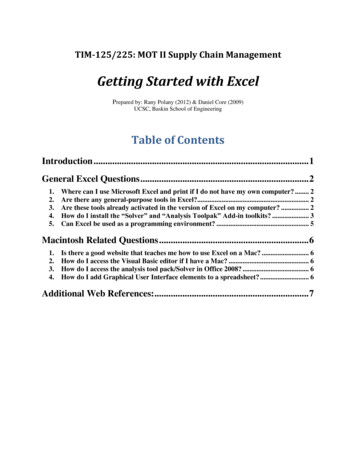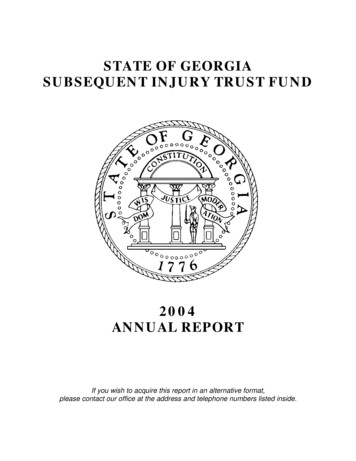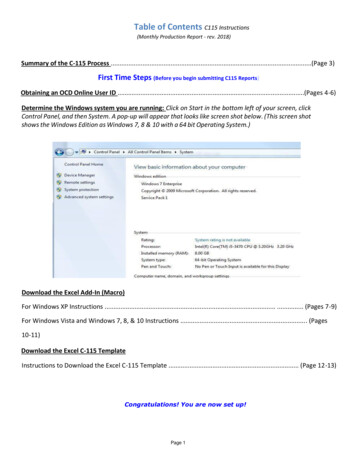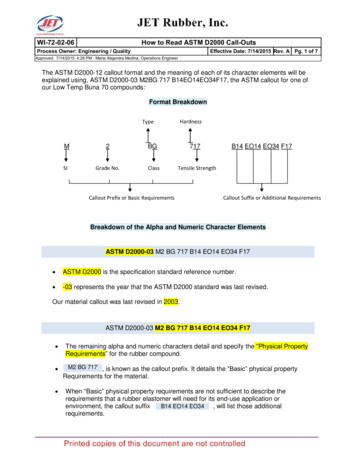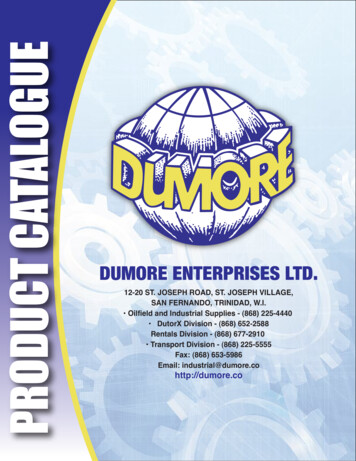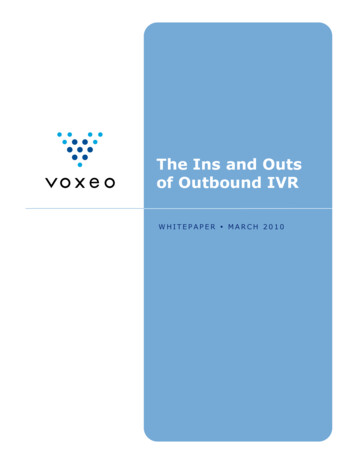
Transcription
The Ins and Outsof Outbound IVRWHITEPAPER MARCH 2010
The Ins and Outs of Outbound IVRAbstract: Datamonitor predicts the market for hosted Outbound Interactive Voice Response(IVR) services in North America alone will more than double from an estimated 213 million in2008 to 524 million by 2013. Outbound IVR offers companies the ability to provide proactivecustomer service, deliver important notifications, expedite collections and more. In order to putthe advantages of Outbound IVR to work for you, it is important to understand the intricacies ofsuccessful outbound calling, how it differs from your Inbound IVR solutions, and the importanceof delivering a cohesive customer experience. This whitepaper will explore the business casefor Outbound IVR and the critical success factors you need to know about before gettingstarted.Table of Contents1Outbound IVR – the Next Big Thing. 32The Business Case for Outbound IVR. 4Outbound IVR vs. Predictive Dialers. 5The Hosting Advantage . 5The Outbound IVR Value Add . 63Success Factors . 6Call Progress Analysis . 6Standards and Ease of Use . 7Relevance . 7Scalability and Reliability . 7Security . 7Regulatory Compliance. 84Voxeo Best Practices. 8CCXML . 8Voxeo CallXML . 9Business Logic. 10Scheduling Outbound Calls . 11Focusing on the Customer Experience. 12Design Once, Deploy Anywhere . 13Multi-site, Worldwide Hosting. 135Summary. 14Page 2 of 15 2009 Voxeo Corporation
The Ins and Outs of Outbound IVR1 Outbound IVR – the Next Big ThingAs companies look to the next big thing that will differentiate their businesses and lower costs,they do so with the realization that customer expectations are at an all-time high. Consumerswant real-time information, faster service, greater convenience and choice. The ability toproactively serve their needs, provide personalized alerts, and quickly communicate with massaudiences are some of the capabilities that make Outbound IVR a valuable component in anyorganization’s customer interaction strategy.Outbound IVR is a technology for delivering automated, phone-based outboundcommunications. Calls can range from personalized, event-triggered notifications and two-wayinteractions to broadcast messages to hundreds or even thousands of customers.Outbound IVR can utilize static, recorded messages or dynamic, speech-enabled dialogs withthe ability to transfer callers to an agent. Application examples include:-New customer welcome messagesProduct availability updatesPersonalized offers and promotionsTravel-related notificationsProblem reportingProblem resolution updatesChange notifications (account status, billing, rates)Interview pre-screeningFraud preventionShipping notificationsOpt-in, subscriber-based servicesSubscription renewalsAppointment remindersInvitations with RSVP capabilitiesTransaction confirmationsPast-due bill reminders with payment processing optionsCustomer surveysCommunity meeting notices-High-volume, time-critical emergency notificationsOutbound IVR offers advantages for businesses of all sizes and across verticals, includingfinancial services, healthcare, government, utilities and education.Page 3 of 15 2009 Voxeo Corporation
The Ins and Outs of Outbound IVR2 The Business Case for Outbound IVROffering new and alternative interaction options can heighten the customer experience and givecompanies a competitive advantage. As part of a holistic customer interaction strategy,Outbound IVR is a mode of interaction that makes it easier for people to do business with yourcompany. When used properly, it can increase customer loyalty and satisfaction.For customer-focused companies the biggest benefit of Outbound IVR is the ability to provideproactive, highly personalized customer service. It enables enterprises to anticipate customerneeds and take action in order to diffuse potentially frustrating situations, streamline processesand improve agent utilization.Outbound IVR, which is often hosted, is not only an affordable communication channel, but alsoone that can result in measurable cost savings. Following are some examples of the efficienciesderived from outbound:-Automate reminder calls, freeing office personnel and call center agents to work onhigher value tasks-Deliver calls outside of office hours, when customers may be easier to reach-Reduce appointment no-shows-Enable immediate and convenient action on notifications – “We see you missed yourflight to Boston this morning. Would you like to book a new flight now?”-Preempt inbound call volume in the contact center by reaching out to customers beforethey call you-Efficiently address an increasing volume of missed payments without tying up valuableagent resources with collection calls-Reach a large number of customers in a short time without having to overstaff agents orinvest in and maintain additional hardware, software or phone lines-Connect with today’s hard-to-reach customer and authenticate their identity beforeinvolving an agent-Maximize IVR port usage by using non-busy hours for proactive customer service-Reduce telephony charges with IP telephony and low-cost SIP bridging-Reduce the expense of paper-based reminders while minimizing the chance ofcommunications being unintentionally delivered to the wrong person, confirming receiptof important messages and being kind to the environmentPage 4 of 15 2009 Voxeo Corporation
The Ins and Outs of Outbound IVROutbound IVR vs. Predictive DialersToday’s Outbound IVR solutions provide significant advantage over cumbersome predictivedialers and auto dialers. Dialer systems are typically located on-site, require staff formaintenance, and are expensive to deploy in a fault-resilient manner that ensures businesscontinuity should one site fail. For example, in a weather-related emergency, predictive dialersgenerally cannot be accessed from a remote location like a hosted Outbound IVR solution.Even worse, administrators may be unable to send emergency notifications at all if their area iswithout power.The ability to deliver a huge volume of calls quickly is also an issue with predictive dialersystems. Think about delivering a one-minute voice message to 1,000 people. A typicalpredictive dialer with two dedicated phone lines would take hours to deliver the message toeveryone, whereas a hosted Outbound IVR system could do it in minutes. A company coulddeploy more dialer ports on site to accommodate these bursts in traffic, but it would be anexpensive undertaking.Of course, the main idea behind a dialer system is to screen no-answers, busy signals anddisconnects so that only live speakers are presented to agents. Outbound IVR goes beyondthat. Applications can leverage speech recognition (ASR) and dual tone multi frequency (DTMF)to verify data and enable interactive self-service – only routing callers to an agent whenassistance is needed. Even in a situation where the goal is to get the called party to a live agent,the IVR greeting and upfront call treatment can be used to avoid dead air issues that often resultin the caller hanging up.The Hosting AdvantageThe majority of Outbound IVR is hosted – a trend that analysts predict to continue. Hostinggives companies the ability to get started quickly and without upfront capital expenses tied todeploying and maintaining the infrastructure needed to deliver interactive outbound calls. This iseven more relevant for companies and service providers who need to deliver important and/ortime-sensitive calls to large audiences. A hosting provider can provide the capacity required tohandle large bursts in call volume.A distributed hosting solution also offers a level of reliability and geographic diversity that isdifficult and expensive to achieve in house. Again, this is of critical importance to governmentagencies, schools, utilities and other organizations that need high availability in order to quicklydeliver essential messages to thousands of people.Hosted Outbound IVR, and hosted IVR in general, also provides low-cost access to the lateststandards and technologies, such as CCXML, speech recognition and speech synthesis, as wellas to next generation SIP-based architectures that ease integration and lower the cost oftransferring calls with direct IP-to-IP connectivity.Page 5 of 15 2009 Voxeo Corporation
The Ins and Outs of Outbound IVRThe Outbound IVR Value AddIn addition to customer service-related applications, Outbound IVR enables consumers to signup to receive highly relevant information and interactions based on profile information andparameters they can control. This could be anything from requesting a message when an outof-stock product is available to scheduling a reminder when tickets to see their favorite artist areabout to go on sale. In addition, companies can use outbound to deliver targeted promotions,up-sell offers and renewal notices.3 Success FactorsIn the beginning there was Inbound IVR. It was good, but often the source of customerfrustration. Then came advancements in speech, open standards and user interface bestpractices that provided the foundation to make Inbound IVR everything it was intended to be.Companies now face a similar learning curve with Outbound IVR. The value is there, although ifnot properly implemented, it can be the source of intense customer frustration.Companies must take great care to deliver Outbound IVR in a manner that customers find ofvalue rather than a nuisance. That means providing an intuitive user interface, a well-tunedapplication, useful information and an overall pleasant experience. However, there is muchmore that goes into Outbound IVR success. Following are some of the factors that can make orbreak an Outbound IVR initiative.Call Progress AnalysisCall Progress Analysis (CPA) is the ability to detect answering machines, fax machines, andother call progress or special information tones such as busy signals, as well as identify when acall is answered by a human. CPA’s detection functions are enabled by media processingalgorithms that are typically provided by DSP boards or host media processing (HMP) software.The ultimate goal of CPA is to quickly and accurately detect the various tones used during callset-up and the possible responses post-connect in order to present the appropriate calltreatment.The challenge is that there are no standards for answering machines. Outbound IVRapplications can encounter personalized outgoing messages, system messages and variedbeep tones. On average, about 5% of answering machines are incorrectly identified as humancontacts, and roughly 5% of human contacts are assumed to be answering machines andabandoned. Unfortunately, the majority of CPA solutions cannot stay in the call after their initialdetection and therefore cannot benefit from advanced error detection techniques and businesslogic that helps increase success rates and prevent call frustration.Page 6 of 15 2009 Voxeo Corporation
The Ins and Outs of Outbound IVRStandards and Ease of UseAn Outbound IVR solution should be based on open industry standards for ease ofdevelopment, cost effective deployment and portability. While VoiceXML addresses the voiceinterface of an IVR application, Call Control XML (CCXML) addresses the need for call controlfunctionality such as placing an outbound call or bridging/managing independent calls (or calllegs). CCXML also allows business-defined logic to govern message delivery, such as theability to define actions based on the call being answered by a human vs. a machine. The fullvalue of CPA cannot be realized without a call control language like CCXML.Open standards also enable straightforward integration with backend systems and existingbusiness logic. VoiceXML and CCXML solutions can even leverage existing enterpriseinvestments in web integration. Any back end server, mainframe, database, or system that hasbeen web or XML-enabled can be rapidly integrated with VoiceXML and CCXML applications.Existing standalone inbound VoiceXML applications can be easily integrated with CCXML andleveraged as a completely standards-based Outbound IVR application.Additionally, XML standards make it easy for administrators, regardless of their location, to usea web interface to easily set up and schedule an Outbound IVR campaign in order to quicklyprovide notifications or react to market opportunities.RelevanceWhen using Outbound IVR for proactive support, sales and marketing, the key is to leveragebusiness intelligence including customer preferences and behaviors in order to make everyoutbound call relevant, targeted and valuable. For instance, as a frequent traveler on ABCAirlines, you may be annoyed to receive an offer for an ABC Airlines branded credit card.However, you would likely be delighted to receive a low-fare alert for a frequently traveled route.Scalability and ReliabilityWhen it’s necessary to send a broadcast message to many recipients in a short time period,such as in the case of a service outage, security threat, or school closing, the ability to burst tohandle spikes in traffic is critical. In these cases it’s equally important to have the reliability ofmultiple, geographically dispersed data centers to ensure service uptime even if one sitebecomes unavailable.SecurityAs is the case with direct mail, its important to avoid unintentionally violating a customer’sprivacy. Validating the identity of the called party is often necessary. In some cases, it’s enoughto insert contact verification steps. The IVR can use a combination of pre-recorded messagesand TTS to announce the intended recipient of the call and verify that whomever answered thePage 7 of 15 2009 Voxeo Corporation
The Ins and Outs of Outbound IVRphone is in fact that person. In other cases, voice verification solutions may be required toprotect sensitive communications common with healthcare and financial companies. Usingvoice verification, a caller’s identity can be authenticated using biometrics and confirmation ofnotification recorded for compliance.Regulatory ComplianceRegulatory agencies have cracked down on practices that result in nuisance complaints whencallers are greeted with silence and long delays. Rules, such as the Telemarketing Sales Rule(TSR), the Fair Debt Collection Practices Act (FDCPA), and the UK’s Persistent MisuseStatement are enforced by the Federal Trade Commission (FTC) and Ofcom.Regulations in most countries stipulate that a connection to an agent or IVR greeting needs tobe made in less than two seconds from the time the call is answered. Outbound IVR with goodCall Progress Analysis can meet these industry requirements.4 Voxeo Best PracticesVoxeo has invested heavily in its Outbound IVR capabilities, which have been battle-tested byenterprise and service provider customers over ten years. Voxeo outbound solutions arecurrently deployed and actively placing millions of calls per day with greater than 96% callclassification accuracy – a success rate that far surpasses the industry average of 80-85%.CPA detection functions, a core component of Outbound IVR, are typically provided by DigitalSignal Processing (DSP) boards or host media processing (HMP) software. However, usingDSP alone for call classification is not enough. Instead, Voxeo combines internally developed,highly accurate DSP with surrounding business logic and standards-based call control to enablecustomizable CPA.Voxeo offers outstanding out-of-the-box accuracy with the ability to further configure parametersassociated with error detection and call handling. Following are some of the unique capabilitiesand best practices that differentiate Voxeo Outbound IVR from other providers.CCXMLVoxeo has provided CCXML hosting since 2001, two times longer than its closest competitor.CCXML is the W3C standard markup language for controlling how phone calls are placed,answered, transferred, conferenced, and more. CCXML works hand-in-hand with VoiceXML toprovide a 100% standards and XML based solution for any telephony application. Today, Voxeohas the most deployed CCXML engine in the world, including OEM deployments with other well-Page 8 of 15 2009 Voxeo Corporation
The Ins and Outs of Outbound IVRknown IVR providers. Voxeo’s CTO, RJ Auburn, is Editor and Chair of the W3C CCXMLstandard and working group.Because VoiceXML is only capable of making an outbound call in the form of a call transfer froman inbound call, Voxeo "wraps" all VoiceXML applications with a stock CCXML script or"wrapper". The wrapper works behind the scenes to give VoiceXML applications the ability toinitiate outbound calls. Using this method, the basic parameters that control CPA detection canbe sent with the outbound call. However, once a CPA event is identified, the VoiceXML dialogstarts and CPA is no longer in the call.The delivery of a robust Outbound IVR application that takes full advantage of CPA requires callclassification and other call control features that are available to application developers usingthe CCXML 1.0 specification.Developing the outbound component of an application in CCXML enables complete control ofthe VoiceXML application at runtime, including the ability to generate XML on the fly or changethe call flow. It also allows CPA to remain in the call – listening for further events and weedingout false “human” or “machine” results.Additionally, Voxeo extensions to CCXML allow the playing of pre-recorded audio promptsand/or messages using speech synthesis (TTS) without starting a VoiceXML dialog. During thisplayback the system may continue with CPA while "listening" to DTMF input. These extensionsto CCXML simplify application development and allow increased port density in the case ofpremise installations.Voxeo’s implementation of CCXML enables recording of both sides of an outbound call, fromstart to finish. This functionality is important in cases where regulations require archived callrecordings. Recording can also be valuable when tuning an application.Voxeo CallXMLVoxeo CallXML is a simple markup language with a short learning curve. It was the first XMLtelephony language with both call control and IVR-like media control. It suits the needs of mosttelephony applications being deployed today, while allowing for faster development of IVRapplications due to its easy-to-learn syntax. CallXML does not require complex SpeechRecognition Grammar Specification Version (SRGS) voice grammars in order to operate.CallXML can initiate new sessions without the need for an originating telephone call. ManyVoxeo customers use CallXML to even further lower the cost and complexity of applicationdevelopment. CallXML enables the same type of CPA advantages derived from using CCXML.Page 9 of 15 2009 Voxeo Corporation
The Ins and Outs of Outbound IVRBusiness LogicVoxeo Outbound IVR applications can receive events with CPA results and take the appropriateaction. Unlike “batch” calling systems, Voxeo’s outbound capability enables customers to definethe business logic associated with the different error tones.Below are the possible results from CPA:-Human - A 'human' result is determined when the duration of initial voice activity is lessthan the specified CPA value-Machine - A 'machine' result is determined when the duration of initial voice activity isgreater than the specified CPA value-Beep - A 'beep' result indicates that CPA's Digital Signal Processing (DSP) hasencountered a pure tone-Modem - CPA has detected a modem-Faxtone - CPA has detected a fax machine-SIT - A 'SIT' result indicates that CPA detected Special Information Tones or SIT tones.This generally means that the called number has been disconnected or is no longer inservice. Voxeo CPA can also detect TTY and TDD devices for the hearing impaired.-Unknown - An 'unknown' result is returned when the CPA runtime expiresCall handling decisions can be made in real time based on returned events. For example, a“human” event may trigger an interactive, speech-enabled application while a “machine” eventresults in the playing of a pre-recorded message.Assume HumanA Voxeo best practice is to assume that all calls are answered by a live human until provenotherwise, and play a VoiceXML dialog as soon as the call is connected. This eliminates thefrustrating dead air a called party may otherwise experience while a “human” vs “machine”decision is made and lowers the number of abandoned calls. CPA events will continue to firewhile the VoiceXML dialog is running. If a “machine” is subsequently detected, the dialog can bestopped midstream and started again to avoid the message being clipped by an answeringmachine, or an entirely different message can be played. This feature is made possible by thecall control functionality in CCXML or CallXML, and the ability for Voxeo CPA to remain listeningon the call.Page 10 of 15 2009 Voxeo Corporation
The Ins and Outs of Outbound IVRMost vendors agree that it is worse to falsely classify a call that is answered by a live person asone that is picked up by an answering machine. This is where the majority of errors occur – andan area where Voxeo offers a clear advantage. Some providers claim that accurate postconnect detection in less than one second is not possible with present day technology and thatit is impossible to accurately detect a live speaker 100% of the time. However, using CCXML orCallXML with Voxeo’s “assume human” approach makes these technology limitations a nonissue.The industry average overall success rate for outbound is between 80% and 85%. By contrast,Voxeo customers using the techniques described typically achieve call classification successrates above 95%.Scheduling Outbound CallsWhen using Voxeo hosting, Outbound IVR campaigns can be scheduled and managed fromany web browser, or originated based on http-based update. Integration with backenddatabases can be used to trigger calls based on business and user-defined events. Ports canbe reserved before placing the call or allocated on demand, after the outbound call has beenplaced and connected.Page 11 of 15 2009 Voxeo Corporation
The Ins and Outs of Outbound IVROnce an Outbound IVR campaign runs, it’s important to understand exactly how and why a callfailed. Unlike VoiceXML, CCXML and CallXML can capture information about the call in theapplication, giving developers access to fine grain call disposition details including the type oferror detected. Since these results are obtained immediately during application run-time, youwill be able to produce accurate real-time reporting with no delays.Focusing on the Customer ExperienceVoxeo makes it easy to leverage backend data and business logic in order to provide cohesiveservice across diverse customer touch points such as voice, SMS, IM and mobile web. Backend application integration can be achieved via Java, SQL, and XML/HTTP.Voxeo streams platform-level log information to a pool of dedicated logging servers. Theseservers automatically index all log information for system administration, customer analysis, andad-hoc trend reporting. At the application layer, VoiceObjects Analyzer uses the same storageto provide more than 50 pre-defined, extensible reports catering to service administrators,application developers, and business analysts – all built on the fault-resilient databaseinfrastructure within Voxeo’s hosting network.Voxeo’s VoiceObjects application development and management tool provides real-timereporting and deep analysis of caller behavior, application performance, and transactionsuccess for rapid tuning, improved ROI and a better customer experience.VoiceObjects integrates with popular business intelligence platforms such as BusinessObjects,and Cognos. Additionally, support for popular ERP and CRM systems, such as SAP, enablestruly personalized customer treatment. With VoiceObjects, interactions can automatically adaptto individuals’ preferences, recent interactions, language preferences and more.Page 12 of 15 2009 Voxeo Corporation
The Ins and Outs of Outbound IVRDesign Once, Deploy AnywhereVoxeo VoiceObjects facilitates a consistent user interface across all customer service portalswith little to no incremental effort; a concept Voxeo calls Unified Self Service . UsingVoiceObjects, a company can build an application once and deploy it across different outboundchannels, including voice, IM, SMS and the mobile web. These phone channels can share theunderlying dialog flow definition, business logic and backend access, drastically simplifyingdevelopment, maintenance, and reporting on these services.Multi-site, Worldwide HostingVoxeo is the largest worldwide VoiceXML and CCXML hosting provider and the only one with a100% uptime guarantee. Multiple, distributed data centers ensure up-time while alleviatingcongestion on the system should one local or regional area experience traffic spike or an outagethat might otherwise impact everyone on the system.The Voxeo platform is built on SIP from the ground up and is light years ahead of thecompetition in the delivery of a clean, scalable SIP backbone that brings together diversePage 13 of 15 2009 Voxeo Corporation
The Ins and Outs of Outbound IVRapplications and devices, eases access to enterprise data and lowers the cost of transferringcalls with direct IP to IP connectivity.Voxeo delivers Inbound and Outbound IVR on the same platform and using the samedevelopment and management tools. Voxeo also offers multiple deployment options based onthe same platform. Users of both our on-demand hosting and premise platform can leveragetheir existing investments in Inbound IVR for Outbound IVR applications and vice versa.The same platform behind Voxeo’s IVR hosting infrastructure is available as a premise solution.Customers may even choose a hybrid deployment, in which Voxeo premise and hostingofferings work together seamlessly. For example, a business could deploy a premise solutionfor their inbound solution and hosting for their outbound campaigns, or use hosting on-demandfor bursting and overflow.5 SummaryOutbound IVR is gaining momentum as companies look for ways to differentiate on customerservice, drive new revenue, and lower costs. Outbound IVR can be a valuable component ofany customer interaction strategy by enabling effective mass communications, proactivecustomer support, and targeted marketing.However, Outbound IVR presents some unique challenges that are not present in thedeployment of an Inbound IVR solution. By using the right technologies and employing provenbest practices, companies can avoid pitfalls that result in customer frustration.Voxeo has extensive experience delivering Outbound IVR applications and was the only vendorto receive a perfect scorecard in Datamonitor’s June 2008 report titled, “Hosted Speech andOutbound IVR Services.” You can read the report for free at:http://www.voxeo.com/about/analysts.jspVoxeo has hosted standards-driven, Outbound IVR applications on its platform for longer thanany provider in the market and understands the unique considerations that are necessary forsuccess. Voxeo support engineers are available around-the-clock, with deep knowledge of theindustry standards and technologies that are critical to the development of a successfuloutbound application. Chances are, if you’ve got an Outbound IVR question, we’ve answered itbefore. Additionally, Voxeo’s free Evolution customer and developer portal is the world’s mostwidely used VoiceXML and CCXML developer community. Evolution provides extensivetutorials, sample applications, sample grammars, discussion forums and developer tools.Companies and service providers considering Outbound IVR can get started instantly and forfree with Voxeo. Contact us today or go to www.voxeo.com/outboundivr.Page 14 of 15 2009 Voxeo Corporation
The Ins and Outs of Outbound IVRContact us
Outbound IVR vs. Predictive Dialers Today's Outbound IVR solutions provide significant advantage over cumbersome predictive dialers and auto dialers. Dialer systems are typically located on-site, require staff for maintenance, and are expensive to deploy in a fault-resilient manner that ensures business





